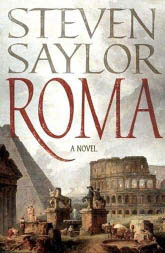 My enthusiasm for Steven Saylor's work dates back to the 1990s when I found a used copy of an audiobook of his detective novel "Arms of Nemesis" at the campus used book store. I found his writing immersed me in the world of 1st century BCE Rome like no one else, with, perhaps, the exception of Colleen McCullough. I snapped up as many of Steven's books as I could and soon felt I was almost a confidante to his hero, Gordianus The Finder. I found his books not only entertaining but filled with fascinating glimpses of events that really happened and served as starting points for me to conduct further research about this empire that our own culture has, in many respects, so closely emulated.
My enthusiasm for Steven Saylor's work dates back to the 1990s when I found a used copy of an audiobook of his detective novel "Arms of Nemesis" at the campus used book store. I found his writing immersed me in the world of 1st century BCE Rome like no one else, with, perhaps, the exception of Colleen McCullough. I snapped up as many of Steven's books as I could and soon felt I was almost a confidante to his hero, Gordianus The Finder. I found his books not only entertaining but filled with fascinating glimpses of events that really happened and served as starting points for me to conduct further research about this empire that our own culture has, in many respects, so closely emulated. I downloaded a copy from Audible.com and embarked on Steven's latest adventure. I was surprised to discover Steven went all the way back to "prehistoric" times to introduce the winged phallus amulet of gold that would become the thread tying each successive generation in the story together.
As the story progresses, I vicariously became a citizen of Roma and experienced its history from a resident's viewpoint. Most novels I have read about the
So, "Roma" is filled with vignettes of characters dealing with the political and social turmoil swirling about its citizens within the city from day to day and from one generation to the next. Beneath it all simmers the class struggle between the noble patricians and the common plebians that seems to escalate with each generation. By focusing on events that shaped the culture and belief systems of the Romans themselves, Steven gives us a window into their thoughts as they grappled with the social upheavals that beset their classical world.
I also did not realize that the
"After many leading citizens had died from the same disease, a slave-girl gave
information to the curule aediles that the reason for this high mortality
was the poisons prepared and administered by the Roman matrons.
On investigation they found about twenty matrons, including patrician
ladies, in the act of brewing poisons, which they declared were
salutary. On being forced to drink their own concoctions to prove
the charges false, they perished by their own wickedness. Following
this, a hundred and seventy more were found guilty of the same
offense."
This incident alone could provide sufficient suspense for a novel in its own right.
I was also intrigued by the interactions among the characters involved with Plautus' playwriting activities. I found the characterization of Publius Cornelius Scipio with his luxurious mane of chesnut hair much more fascinating than the man I imagined when I gazed upon the strained face and bald head of Scipio's extant bust. Steven’s Scipio was truly the personification of a "Roman Alexander".
The vivid portrayal of the riots surrounding the murder of Tiberius Gracchus also brought the turmoil of that period to life for me. As I read about one of the characters making a flailing descent from the Tarpeian Rock, grasping at other men clutching roots and outcroppings in an attempt to break their fall, I couldn't help but visualize their desperation and recall my own view from the promontory the modern Romans advertise as the Tarpeian Rock that overlooks the remains of the Forum Romanum. Then I shuddered at the thought of trying to make my way across a corpse-glutted
1 comment:
Thanks for the review of Saylor's "Roma". I discovered it while trolling Amazon.com, but thought it still a bit pricy. I usually wait for used copies to pop up. But now I may well reconsider and go ahead and get it anyway. I have always loved Saylor and his characterizations of historical figures. So "Roma" sounds like just my cup of tea.
M. A. George
Post a Comment